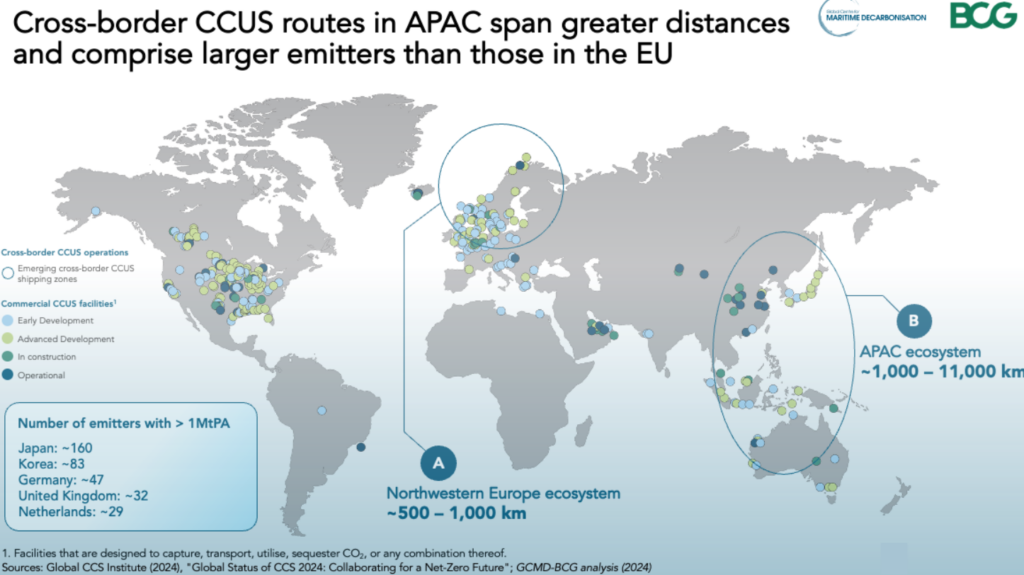By 2050, Asia Pacific (APAC) countries could require up to 150 vessels to transport an estimated 100 million tons per annum (MtPA) of captured CO2 across national borders, according to a
By 2050, Asia Pacific (APAC) countries could require up to 150 vessels to transport an estimated 100 million tons per annum (MtPA) of captured CO2 across national borders, according to a new report.
The “Opportunities for Shipping to Enable Cross-border CCUS Initiatives”is a joint study published by the Global Centre for Maritime Decarbonization (GCMD) and Boston Consulting Group (BCG).
The report found that shipping CO2 will be especially important in Asia Pacific due to the vast oceans and seas that separate emitters and sequestration sites when compared to Europe. To address this, several APAC governments, including Australia, Indonesia, Japan, Malaysia, Singapore and South Korea, are pursuing cross-border partnerships and initiatives to support cross-border CO2 transportation and sequestration.
Furthermore, the study estimated that approximately 100 million tons per annum (MtPA) of CO2 captured using carbon capture technologies is expected to be transported across national borders in APAC by 2050.
Transporting this annual tonnage would require between 85 to 150 liquefied CO2 (LCO2) carriers of 50 kt capacity where the total investments needed for these vessels by 2050 could reach up to $25 billion.
Creating a market of this scale will necessitate concerted efforts from both the public and the private sector, including economic incentives, long-term contracts for midstream players, and greater clarity on key standards, according to the GCMD and BCG.
Key components needed to activate cross-border CO2 shipping for CCUS
The study identified three components that governments and private sector players must provide to activate the shipping industry for cross-border carbon capture, utilization, and sequestration (CCUS) initiatives. These include:
- Direct economic support: Governments can extend economic assistance to midstream players, such as shipping and port providers, through financial incentives and new business models. These measures can reduce upfront capital expenditure and overall project costs, making cross-border CO2 shipping more viable.
- Long-term contracts and minimum volume guarantees: Emitters need to provide long-term contracts to shipping and terminal providers – ideally 10 years or more – and commit to transporting a minimum volume of CO2. This will give value chain participants greater certainty for planning and obtaining necessary financing for investments in vessels and terminal capacity.
- Clarity on standards and specifications for shipping: Shipping providers need clear regulations and guidelines on the standards governing tolerance limits for impurities in CO2 cargo, operating pressures, and temperatures along the value chain.
CCUS’s success depends on developing all parts of its value chain, including shipping and storage. The report stressed that by collaborating and addressing the challenges identified in this study, both public and private stakeholders can develop the full CCUS value chain.
“Our study shows that APAC has the potential to lead in CO2 shipping. In APAC, emitters and sinks are often separated by large bodies of water over vast distances, unlike Northern Europe where CCUS facilities are more geographically concentrated. This makes shipping a more attractive mode of CO2 transport in APAC, underscoring the importance of building up a shipping ecosystem,” Professor Lynn Loo, CEO of GCMD, said.
She added that the effort to establish this value chain should entail constructing CO2 carriers, developing port-side infrastructure, establishing standards and guidelines for transporting and offloading CO2, and upskilling crew with requisite training.
Related Article
-
 Posted: 6 months ago
Posted: 6 months agoDNV: Commercial uptake of OCC relies on industry collaboration
Categories:- Business Developments & Projects
Posted: 6 months ago
“The unique distribution of large emitters and sequestration sites across APAC offers significant opportunities for CO2 shipping and cross-border CCUS. Northeast Asian emitting countries have a chance to drive technological innovation and strengthen their leadership in commodity shipping, while Southeast Asia and Australia can utilise their vast depleted oil and gas and other storage assets, to foster green economy growth and international collaboration,”Carl Clayton, Partner & Associate Director, Global Co-Lead for BCG’s CCUS Topic stated.
“Government support will be essential in the short term to ensure economic viability and to address cross value chain risks. Additionally, the industry must align on technical specifications, including CO2 pressure, temperature, and purity specifications, to enable seamless operations and infrastructure interoperability.”

Economic and regulatory gaps
Scaling up cross-border CCUS requires significant investment in shipbuilding, port infrastructure, and terminals, according to the report.
Related Article
-
 Posted: 4 months ago
Posted: 4 months agoNYK: Cost reduction is the most important factor in promoting CCS
Categories:- Carbon Capture Usage & Storage
Posted: 4 months ago
The cost of transporting CO2 across borders, including capture and shipping, ranges from $141-174 per ton for Southeast Asia routes to $167-287 per ton for Northeast Asia-Australia routes. Capture and shipping make up 60-80% of the total cost, it was revealed.
However, there is a large gap between these costs and current carbon pricing in the Asia-Pacific region, where carbon taxes and emissions trading prices are only $2 to $18 per ton of CO2. This price difference, roughly ten times lower than CCUS costs, could slow the development of cross-border CCUS without additional financial support, the report stated.
Additionally, unclear and underdeveloped regulations could also hinder progress. Countries need to create rules for carbon accounting, verification, and permitting for cross-border CCUS projects, the partners highlighted.
Bilateral and multilateral agreements are also necessary to define jurisdiction, responsibility for CO2 leaks, and liabilities across the value chain. Clear regulations and frameworks would reduce risks, making it easier for developers to move forward with CCUS projects, the report concluded.
READ MORE
Content Original Link:
" target="_blank">


























































